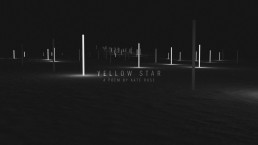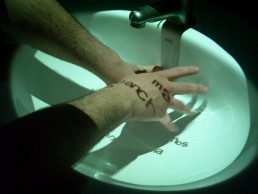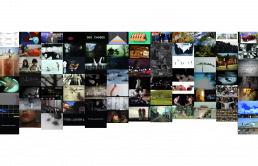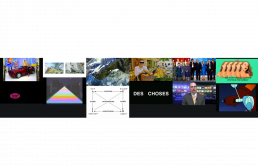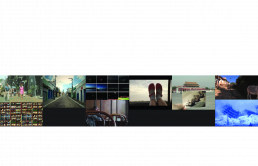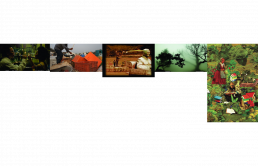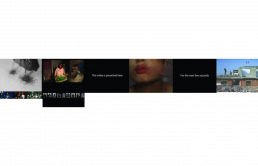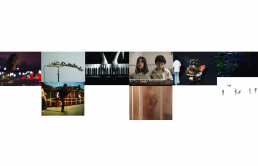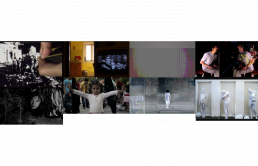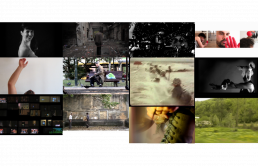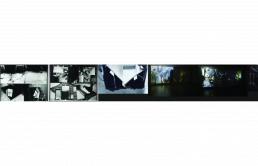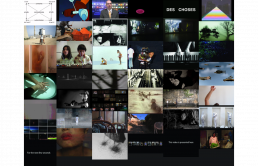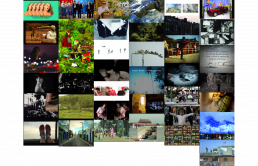“FUSO 2012 – 21 Agosto a 7 Setembro“
Programa
26 Agosto, 19h
Clube Ferroviário
O Olhar e a Palavra
Curadoria de Isabel Nogueira
O olhar e a palavra. Podemos dizer que tudo começa assim.
A comunicação. O dar-se ao outro e recebê-lo por intermédio de um suporte e de uma linguagem. Num tempo e espaço determinados. Hoje estamos aqui. Quer dizer, neste espaço e neste momento.
A sessão que se apresenta opera uma escolha e uma simultânea reflexão sobre o universo da literatura na vídeo arte, conferindo especial enfoque à poesia. Nesta vertente, escolheram-se autores, como T. S. Eliot, Billy Collins, Sylvia Plath, Rainer Maria Rilke, Ezra Pound ou Dylan Thomas.
Por outro lado, e do ponto de vista da seleção dos vídeos, as propostas passam pelo profícuo universo “Fluxus”, movimento que surge no contexto da neovanguarda dos anos sessenta e que precisamente reintroduz uma ligação direta com a vida, ligação reiterada e desenvolvida com o tempo real do vídeo: “A arte é a vida e a vida é a arte”.
Contudo, esta proposta de visionamento pretende também ser eclética, e como tal traz à nossa presença não só artistas menos conhecidos, como também trabalhos diversificados, desde a animação ao universo do poema visual.
O olhar e a palavra. Podemos dizer que tudo começa assim.
Ross West, The Man in the Black Coat, 2011, 2’30’’
The Man in the Black Coat é uma obra de poesia visual sobre o poema Yellow Star de Kate Ruse. Yellow Star refere-se à estrela de David usada pelos Nazis durante o Holocausto como meio de identificação de Judeus.
Blanca Giménez, Lavabo interactivo, 2010, 1’07’’
Lavabo interativo é uma instalação interativa que consiste num lavatório colocado numa parede. Quando o espectador coloca as suas mãos por baixo da torneira, começa a ouvir o som de água a correr e também um extrato de Macbeth de Shakespeare.
Com a sua presença, o público também ativa a projeção de algumas letras que gradualmente formam palavras do texto escolhido. Quando tiram as mãos do lavatório, o som desliga e as letras projetadas inevitavelmente desaparecem pelo cano de esgoto.
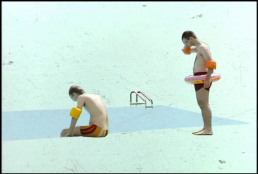
Julian Grey, Forgetfulness, 2007, 1’50’’
Forgetfulness apela ao realizador Julian Gray por causa da implicação de imagens ou memórias que escapavam com o passar do tempo. O melhor meio que ele sentia que poderia remeter para o passado seria a película super 8, geralmente usada para filmagens caseiras, um padrão na história visual de muitas famílias pré-digitais do pós-guerra. A partir da colagem, Gray pegou na película, removeu seletivamente pessoas e fundos e usou técnicas para envelhecer as imagens, arranhando, desbotando ou branqueando o material em si, criando a impressão de pensamentos a desvanecerem.
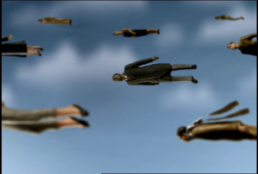
Julian Grey, Some Days, 2007, 1’09’’
Em Some Days, o autor, Billy Collins, usa a metáfora de uma casa de bonecas e das próprias bonecas, para demonstrar a manipulação da vida, que habilmente, inverte para sugerir a manipulação das nossas próprias. Julian Grey opta por usar os detalhados elementos de um diorama, transformando-os num cenário assustador composto por elementos reais e surreais. A utilização dessas pequenas figuras, proporcionou a utilização de interessantes técnicas de câmara em espaços mínimos com pouca profundidade de campo, transmitindo uma forte sensação de manipulação e contenção.

Julian Grey, Budapest, 2007, 0’55’’
Em Budapeste, Collins descreve o devaneio de um escritor, evocando um mundo estranho no qual a sua mão ganha vida própria. O realizador Julian Grey visualiza uma mão segurando uma caneta de aparo, que na mesa encontra uma floresta fantástica onde insetos e animais desenham a vida através de um oásis de tinta.
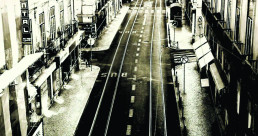
Raquel Castro, A cidade: Fernando Pessoa, 1’39’’
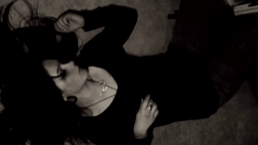
Josep Porcar, Lady Lazarus – Sylvia Plath, 2009, 6’29’’

Swoon, The Moon and the yew tree – Sylvia Plath, 2011, 5’
Neste poema Sylvia Plath repara nos seus arredores em Green Court, e percebe o impacto simbólico que o ambiente tem sobre o seu humor e todo o seu estado de espírito. Na essência, o que ela vê por fora é uma manifestação do que ocorre no seu interior. Swoon faz o mesmo com imagens e música. Num dia de nevoeiro filma a paisagem desfocada para expressar exatamente o mesmo humor e estado de espírito que sentia. Cria uma paisagem sonora para entrelaçar a emotiva leitura de Nic Sebastian.
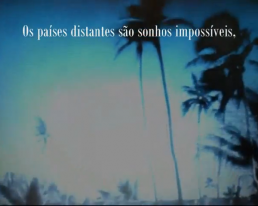
Rui Pires Cabral, Os países distantes, 2012, 2’40’’

Rui Pires Cabral, Atlantic, 2012, 2’03’’
“FUSO 2012 – August 21 to September 7“
Program
August 26, 7pm
Clube Ferroviário
The Look and the Word
Curatorship by Isabel Nogueira
The look and the word. We can say that everything begins like this.
Communication. Giving themselves to others and receive it through a medium and a language. In a certain time and space. Today we are here. I mean, in this space and in this very moment.
This presented session operates a choice and a simultaneous reflection on the literature universe in video art, giving special emphasis to poetry. Regarding this subject, were chosen authors such as T. S. Eliot, Billy Collins, Sylvia Plath, Rainer Maria Rilke, Ezra Pound and Dylan Thomas.
On the other hand, and from the point of view of this selection, the proposals pass through the profitable universe “Fluxus”, a movement that emerges in the context of the neo-avant-garde of the sixties and which precisely reintroduces a direct connection with life itself, a repeated and developed link with the real time of the video: “Art is life and life is art”.
However, this screening proposal also intends to be eclectic, and as such to bring to our presence not only lesser known artists, but also diversified works, from the animation field to the visual poem.
The look and the word. We can say that everything starts with this.
Ross West, The Man in the Black Coat, 2011, 2’30’’
The Man in the Black Coat is a piece of visual poetry based on the poem Yellow Star by Kate Ruse. Yellow Star refers to the yellow-coloured Star of David used by the Nazis during the Holocaust as a method of identifying Jews.
Blanca Giménez, Lavabo interactivo, 2010, 1’07’’
Lavabo interactivo (Interactive washbasin) is an interactive installation that consists in a washbasin placed on a wall. When the viewer puts his/her hands under the tap, he/she begins to hear the sound of water flowing, as well as the reading of an extract from Shakespeare’s Macbeth.
With its presence, the audience also activates the projection of some letters which gradually make up some words from the chosen text. When they take their hands out of the washbasin, the sound switches off and the letters projected inevitably disappear in the wastepipe.

Julian Grey, Forgetfulness, 2007, 1’50’’
“Forgetfulness”, appealed to director, Julian Grey because of its implication of images or memories slipping away with the passage of time. The best medium he felt to connote the past was Super 8 film, usually used in home movies, a standard in the visual history of many a post-War, pre-digital family. Using a collage approach, Grey took the film, and selectively removed people and backgrounds and used techniques to age the footage by actually scratching, fading, or bleaching the medium itself creating the impression of thoughts slipping away.

Julian Grey, Some Days, 2007, 1’09’’
In Some Days, the author Billy Collins uses the metaphor of a dollhouse and dolls to demonstrate the manipulation of life, and then he cleverly reverses it to suggest that our own lives are being manipulated. Grey opted to use detailed miniature figurines such as those found in a railroad set of dioramas and recasts them in a spooky model house containing both real and surreal elements. By using these small figures, he could play with interesting camera techniques in tight spaces with low depth of field, evoking a strong sensation of manipulation and restraint.

Julian Grey, Budapest, 2007, 0’55’’
Julian Grey, Budapest, 2007, 0’55’’
In Budapest, Collins describes the daydream of a writer, conjuring a strange world in which the writer’s hand goes off on its own. The director Julian Grey visualized a rodent-like hand clutching a pen that forages through a desk/forest fantasy world where calligraphic bugs and animals draw life from an oasis of ink.

Raquel Castro, A cidade: Fernando Pessoa, 1’39’’

Josep Porcar, Lady Lazarus – Sylvia Plath, 2009, 6’29’’

Swoon, The Moon and the yew tree – Sylvia Plath, 2011, 5’
In this poem Sylvia Plath takes inventory of her surroundings at Court Green and soon begins to notice the symbolic impact her environment has on her entire mood and state of mind. In essence, what she sees outwardly is a manifestation of what is occurring on the inside of her being. Swoon does the same with the images and music. On a foggy day, he recorded the blurry landscape to express exactly the same mood and state of mind she was in at the time. He made a soundscape to interweave the moody reading by Nic Sebastian.

Rui Pires Cabral, Os países distantes, 2012, 2’40’’

Rui Pires Cabral, Atlantic, 2012, 2’03’’
